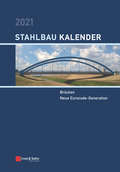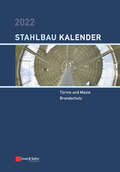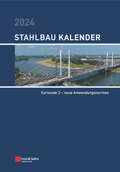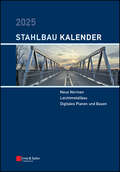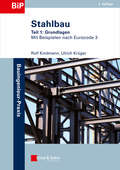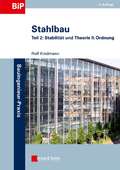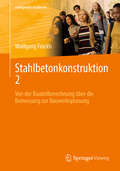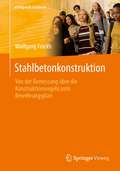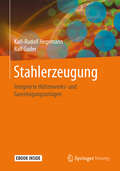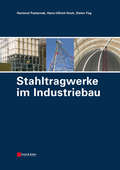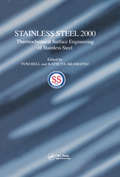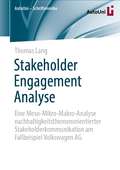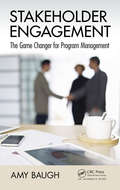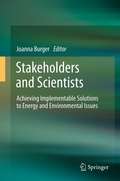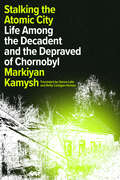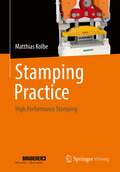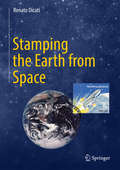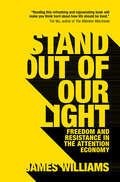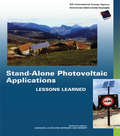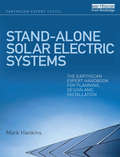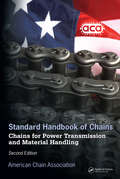- Table View
- List View
Stahlbau-Kalender 2021: Schwerpunkte: Brücken; Neue Eurocode-Generation (Stahlbau-Kalender)
by Ulrike KuhlmannDie Schwerpunktthemen des Stahlbau-Kalender 2021 sind der Brückenbau und die neue Eurocode-Generation. Brücken aus Stahl zeichnen sich durch eine hohe Lebensdauer und eine hervorragende Tragfähigkeit aus. Durch Kombination mit anderen Materialien sind den Möglichkeiten im Stahlbrückenbau, einschließlich der architektonisch anspruchsvollen Gestaltung, keine Grenzen gesetzt. Brückenneubauten oder Ersatzneubauten unter laufendem Verkehr erfordern innovative Lösungen mit Fokus auf kurzen Bauzeiten bei gleichzeitiger Ressourcenschonung. Dafür eignen sich besonders Brückentypen mit hohem Vorfertigungsgrad und in Modulbauweise, wie z. B. Stahlverbundbrücken mit Fertigteilen. Dank der großen Spannweiten, die sich mit dem Baustoff Stahl erreichen lassen, können Kosten und Aufwendungen für die Mittelstütze und beengende Verkehrsführungen eingespart werden. Den vielfältigen Planungsaufgaben beim Entwurf von Stahl- und Stahlverbundbrücken wird in dieser Ausgabe des Stahlbau-Kalender mit Beiträgen über Richtzeichnungen, Vorplanung, Fertigung und Montage, Brückenseile, Brückenlager, Fahrbahnübergänge und Ermüdungsfestigkeit Rechnung getragen. Als ein grundlegendes Thema des Stahlbaus wird das Beulverhalten und die Optimierung schlanker Stahlkonstruktionen in einem ausführlichen Beitrag aktuell behandelt. Der Stahlbau-Kalender dokumentiert verlässlich und aus erster Hand den aktuellen Stand der Stahlbau-Regelwerke. In dieser Ausgabe werden neben der Aktualisierung von Teil 1-8 "Bemessung von Anschlüssen" auch Erläuterungen zur Neubewertung des Kerbfallkatalogs nach DIN EN 1993-1-9 - Ermüdung - Ausgabe August 2020 und zur DASt-Richtlinie über die Ermüdungsbemessung bei Anwendung höhenfrequenter Hämmerverfahren gegeben.
Stahlbau-Kalender 2022: Türme und Maste, Brandschutz (Stahlbau-Kalender)
by Ulrike KuhlmannEin Schwerpunkt des Stahlbau-Kalenders 2022 ist der Brandschutz, der existenziell für die Stahlbauweise ist. Die ganzheitliche Betrachtung des vorbeugenden Brandschutzes unter Berücksichtigung der nutzungsbedingten Gefährdungspotentiale und Schutzziele spielt bei der Planung und Errichtung von Bauwerken eine wesentliche Rolle. Planung und Entwurf mithilfe von Brandschutzkonzepten und Naturbrandmodellen können vorteilhafte, wirtschaftliche Konstruktionen hervorbringen. Mit dem zweiten Schwerpunktthema Türme und Maste behandelt dieser Kalender ein Spezialthema des Stahlbaus mit seinen spezifischen Konstruktionsformen und Einwirkungen, insbesondere aus Wind. Der Stahlbau-Kalender dokumentiert verlässlich und aus erster Hand den aktuellen Stand der Stahlbau-Regelwerke. In diesem Sinne werden, neben der Aktualisierung des Kommentars zu Eurocode 3 Teil 1-1 "Bemessungsregeln für den Hochbau", die neuen Entwicklungen zur Regelung der "Brandeinwirkungen auf Tragwerke" in prEN 1991-1-2 und der "Tragwerksbemessung für den Brandfall" in prEN 1993-1-2 dargestellt und erläutert. Wie immer bewegen sich alle Kapitel nahe an der Ingenieurpraxis und enthalten zahlreiche Beispiele. Das Buch ist ein Wegweiser für die richtige Berechnung und Konstruktion im gesamten Stahlbau mit neuen Themen in jeder Ausgabe. Herausragende Autoren aus der Industrie, aus Ingenieurbüros und aus der Forschung vermitteln Grundlagen und geben praktische Hinweise.
Stahlbau-Kalender 2023: Schwerpunkte: Werkstoffe, Verbindungen (Stahlbau-Kalender)
by Ulrike KuhlmannDer Stahlbau-Kalender 2023 widmet sich mit "Werkstoffe" und "Verbindungen" zwei Schwerpunkten, die zusammenwirken, denn die Auswahl der Stahlsorten und die Wahl der Verbindungen sind für wirtschaftliche und nachhaltige Entwürfe und Konstruktionen essentiell. Der Stahlbau-Kalender dokumentiert verlässlich und aus erster Hand den aktuellen Stand der Stahlbau-Regelwerke. In diesem Sinne werden, neben der Aktualisierung des Kommentars zu Eurocode 3 Teil 1-8 "Bemessungsregeln von Anschlüssen", vor dem Hintergrund der Entwicklung der zweiten Eurocode-Generation die wesentlichen strukturellen und technischen Änderungen vorgestellt und erläutert. Neben dem klassischen Baustahl werden die nichtrostenden Stähle betrachtet, die z. B. bei Außenbauteilen wie Fassadenkonstruktionen, aber auch in anderen Fällen, den Ausschlag für Projekte in Stahlbauweise geben. Wie immer bewegen sich alle Kapitel nahe an der Ingenieurpraxis und enthalten zahlreiche Beispiele. Das Buch ist ein Wegweiser für die richtige Berechnung und Konstruktion im gesamten Stahlbau mit neuen Themen in jeder Ausgabe. Herausragende Autoren aus der Industrie, aus Ingenieurbüros und aus der Forschung vermitteln Grundlagen und geben praktische Hinweise.
Stahlbau-Kalender 2024: Schwerpunkte: Eurocode 3 - neue Anwendungsnormen (Stahlbau-Kalender-eBundle (Ernst & Sohn))
by Ulrike Kuhlmann Herausgegeben VonDer Stahlbau-Kalender 2024 dokumentiert wiederum verlässlich und aus erster Hand den aktuellen Stand der Stahlbau-Regelwerke. In diesem Sinne werden, neben der Aktualisierung des Kommentars zu Eurocode 3 Teil 1-1 "Allgemeine Bemessungsregeln", vor dem Hintergrund der Entwicklung der zweiten Eurocode-Generation die wesentlichen strukturellen und technischen Änderungen vorgestellt und erläutert. Die neuen Entwürfe zu den Eurocode 3 Teilen 1-11 und 1-14 sowie Teil 2 und Teil 5 werden auszugsweise in deutscher Übersetzung wiedergegeben und die Änderungen gegenüber den derzeit gültigen Fassungen dokumentiert. Die zugrunde liegenden aktuellen Forschungsergebnisse werden erläutert. Zahlreiche Anwendungs- und Berechnungsbeispiele fördern das Verständnis der neuen Regelungen. Darüber hinaus werden Hinweise und Beispiele zur Berechnung typischer Stahlkonstruktionen, wie z. B. Windenergieanlagen oder Strukturen aus Winkelprofilen mit geschraubten Anschlüssen, gegeben. In bewährter Weise bewegen sich alle Kapitel nahe an der Ingenieurpraxis und enthalten zahlreiche Beispiele. Das Buch ist ein Wegweiser für die richtige Berechnung und Konstruktion im gesamten Stahlbau mit neuen Themen in jeder Ausgabe. Herausragende Autoren aus der Industrie, aus Ingenieurbüros und aus der Forschung vermitteln Grundlagen und geben aktuelle praxisbezogene Einführungen.
Stahlbau-Kalender 2025: Schwerpunkte: Neue Normen; Leichtmetallbau; Digitales Planen und Bauen (Stahlbau-Kalender)
by Ulrike KuhlmannThe book explains parts of the new EC generation. It also contains articles on sandwich elements, design in lightweight steel construction and aluminium structures. The future topics of AI and additive manufacturing are presented with practical applications. With many examples.
Stahlbau: Teil 1: Grundlagen (Bauingenieur-praxis Ser.)
by Rolf Kindmann Ulrich KrügerThe book imparts basic knowledge for the detailing of steel structures and for the structural design of steelwork according to Eurocode 3 with Parts 1-1 (Building Elements) and 1-8 (Joints). With extensive examples. The book has been completely revised for the 5th edition.
Stahlbau: Teil 2 - Stabilität und Theorie II. Ordnung (Bauingenieur-Praxis)
by Rolf KindmannThe central themes are structural stability, the determination of loading according to 2nd order theory and the verification of load-bearing capacity. The actual load-bearing behaviour is explained, suitable verification procedures are recommended and illustrated with examples.
Stahlbetonkonstruktion 2: Von der Bauteilberechnung über die Bemessung zur Bauwerksplanung (erfolgreich studieren)
by Wolfgang FinckhAufbauend auf dem ersten Teil „Stahlbetonkonstruktion“ werden in diesem Teil erweiterte Grundlagen der Stahlbetonberechnung erläutert. Neben den Torsionsnachweisen, dem genaueren Verfahren zur Durchbiegeberechnung und den Schnittgrößenumlagerungen werden vor allem besonders häufig vorkommende Stahlbetonbauteile behandelt. Zu diesen Bauteilen zählen Aussteifungssysteme, Bodenplatten, Fundamente, liniengelagerte Platten sowie Elementdecken. Hierbei werden bei diesen Bauteilen, welche nahezu in jedem Bauwerk vorkommen, sowohl die Ermittlung der Schnittgrößen wie auch die Bemessung und konstruktive Durchbildung erklärt. Zusätzlich wird in diesem Lehrbuch auch die Bemessung des Werkstoffes Stahlfaserbeton, welcher insbesondere bei Bodenplatten im Industriebau verwendet wird, erläutert. Die im Lehrbuch vorgestellten theoretischen Grundlagen werden anhand zahlreicher Abbildungen verdeutlicht. In jedem Kapitel sind zum besseren Verständnis umfangreiche Bemessungsbeispiele mit Praxisbezug enthalten. Nach der erfolgreichen Lektüre des ersten Bandes der Reihe „Stahlbetonkonstruktion“ wird in diesem zweiten Band das Wissen gefestigt und stark erweitert. Dies ermöglicht dem Lesenden einen sicheren Umgang mit dem Werkstoff Stahlbeton.
Stahlbetonkonstruktion: Von der Bemessung über die Konstruktionsregeln zum Bewehrungsplan (erfolgreich studieren)
by Wolfgang FinckhDie Grundlagen der Berechnung von Stahlbetonbauteilen werden in diesem Lehrbuch anhand der mechanischen Beziehungen erläutert. Ausgehend von den Nachweisen für Biegung und Querkraft werden auch die Berechnungen für die im Hochbau üblichen Stahlbetonbauteile, wie Balken, Platten, Stützen und Flachdecken erarbeitet. Neben den Nachweisen für Trag- und Gebrauchstauglichkeit werden aufbauend auf den Bemessungsergebnissen die Konstruktionsregeln und Bewehrungsführungen umfangreich dargestellt.Die im Lehrbuch vorgestellten theoretischen Grundlagen werden anhand zahlreicher Abbildungen erläutert. In jedem Kapitel sind zum besseren Verständnis umfangreiche Bemessungsbeispiele mit Praxisbezug enthalten.Um die LeserInnen für die Baupraxis vorzubereiten, werden auch die Erstellung von statischen Berechnungen, Schalplänen und von Bewehrungsplänen behandelt. Damit wird für den Hochbau eine umfassende Basis des Stahlbetonbaus vermittelt, welche einen erfolgreichen Start ins Berufsleben gewährleistet.
Stahlerzeugung: Integrierte Hüttenwerks- und Gasreinigungsanlagen
by Karl-Rudolf Hegemann Ralf GuderDieses Buch gibt einen Überblick über die Stahlerzeugung von den Anfängen bis zu den heutigen Verfahren. Es erklärt die Verfahrenstechnik, Berechnungsgrundlagen und den aktuellen Stand der Technik sowohl für Rohstahl als auch für Stahlrecycling.
Stahltragwerke im Industriebau
by Hartmut Pasternak Dieter Füg Hans-Ullrich HochThe book deals with a significant area of steel construction ? industrial building. The eight chapters describe all the important aspects of this field. A reference book for daily tasks and for rapid introduction into new fields of work.
Staining and Varnishing
by David HollowayDavid Holloway takes you through all the steps needed to stain and varnish wood. Chapters start from the basics and takes the reader to more advanced staining tips and techniques.
Stainless Steel 2000: Thermochemical Surface Engineering of Stainless Steel
by Tom Bell; Katsuya AkamatsuAustenitic stainless steels lend themselves to a wide range of applications. However, they normally stiffer from poor wear resistance and do not respond well to traditional surface treatments. This volume. the fruit of a current status seminar, reflects the enormous strides which have been made in the last few years in the study of the expanded austenite phase (also called the S phase) and the development of new surface treatment techniques. As well as the papers presented at the seminar, the book contains selection from related papers and a comprehensive bibliography of the literature on the subject from 1979 to 2000.
Stainless Steel Wires-Engineered Multifunctional Ultra-High Performance Concrete
by Baoguo Han Xinyue Wang Sufen DongThe emergence and application of stainless steel wires-engineered multifunctional ultra-high performance concrete advances the safety, durability, function/intelligence, resilience, and sustainability of infrastructure, thus prolonging the service life and reducing the maintenance to lower the lifecycle cost of infrastructure. This is the first reference work on this multifunctional concrete, which combines high performance with functional/ smart properties, such as thermal, electrical, self-sensing, and electromagnetic properties, as well as a sustainable profile. The book delivers both fundamentals and applications about multifunctional concrete, covering basic principles, properties, mechanisms, engineering application cases, and future development challenges and strategies. Stainless Steel Wires-Engineered Multifunctional Ultra-High Performance Concrete opens up a new horizon for researchers and specialist technologists in the field of concrete materials and structures.
Staircases - Structural Analysis and Design
by M.Y.H. BangashIn recent years both free-standing and geometric staircases have become quite popular. Many variations exist, such as spiral, helical, and elliptical staircases, and combinations of these. A number of researchers have come forward with different concepts in the fields of analytical and numerical design and of experimental methods and assessments. The aim of this book is to cover all these methods and to present them with greater simplicity to practising engineers. Staircases is divided into five chapters: Specifications and basic data on staircases; Structural analysis of staircases – Classical methods; Structural analysis of staircases – Modern methods; Staircases and their analysis – A comparative study; Design analysis and structural detailing. Charts and graphs are included and numerous design examples are given of freestanding and other geometric staircases and of their elements and components. These examples are related to the case studies which were based on staircases that have already been constructed. All examples are checked using various Eurocodes. The book includes bibliographical references and is supported by two appendices, which will be of particular interest to those practising engineers who wish to make a comparative study of the different practices and code requirements used by various countries; detailed drawings are included from the USA, Britain, Europe and Asia. Staircases will serve as a useful text for teachers preparing design syllabi for undergraduate and post graduate courses. Each major section contains a full explanation which allows the book to be used by students and practising engineers, particularly those facing the formidable task of having to design/ detail complicated staircases with unusual boundary conditions. Contractors will also find this book useful in the preparation of construction drawings and manufacturers will be interested in the guidance given.
Stakeholder Engagement Analyse: Eine Meso-Mikro-Makro-Analyse nachhaltigkeitsthemenorientierter Stakeholderkommunikation am Fallbeispiel Volkswagen AG (AutoUni – Schriftenreihe #153)
by Thomas LangAm Fallbeispiel der Volkswagen AG Nachhaltigkeit werden erstmalig auf der Grundlage eines sozialtheoretisch inspirierten Mehrebenen-Analysemodells die Wahrnehmungen und Zuschreibungen von Unternehmensverantwortung (Corporate Responsibility) durch 33 nichtmarktliche Stakeholder aus den drei Bezugsgruppen Wissenschaft und Forschung, Politik und Verbände sowie NGOs untersucht. Die qualitative Fallstudie beschreibt kenntnisreich und detailliert, wie der Volkswagen-Konzern mit seinen wesentlichen, nichtmarktlichen Stakeholdergruppen interagiert. Den theoretischen Bezugsrahmen der Arbeit bilden Anthony Giddens Theorie der Strukturation, Edward R. Freemans Stakeholder-Management- und Amartya Sens Capability-Ansatz.
Stakeholder Engagement: The Game Changer for Program Management (Best Practices in Portfolio, Program, and Project Management #18)
by Amy BaughStrong stakeholder engagement is perhaps the most critical factor for achieving successful program execution in our fast-paced world. Many program managers get stuck in the "science" of program management, spending vast amounts of effort on tasks, charts, and metrics. Program managers who emphasize activities around relationship building and stakeh
Stakeholders and Scientists
by Joanna BurgerNation and the World must move forward with development of a range of energy sources and savings, all with attendant environmental problems. Solving these problems, and those remaining from past energy-related activities, will require iteration, inclusion, and collaboration with a wide range of stakeholders, including U.S., State and local governmental agencies, Tribal Nations, scientists, environmentalists, public policy makers, and the general public.
Stalking the Atomic City: Life Among the Decadent and the Depraved of Chornobyl
by Markiyan Kamysh&“His voice must be heard.&”—Patti Smith&“A poetic rush to madness. . . a stunning, original voice as lyrical as it is unnerving."—Alan Weisman, author of The World Without Us and Countdown"In the shadow of catastrophe, Markiyan Kamysh writes with all of youth&’s wayward lyricism, like a nuclear Kerouac."—Rob Doyle, author of ThresholdA rare portrait of the dystopian reality of Chornobyl, Ukraine, as it was before the Russian occupation of 2022.Since the nuclear disaster in April 1986, Chornobyl remains a toxic, forbidden wasteland. As with all dangerous places, it attracts a wild assortment of adventurers who feel called to climb over the barbed wire illegally and witness the aftermath for themselves. Breaking the law here is a pilgrimage: a defiant, sacred experience mingled with punk rock, thrash metal, death, decay, washed down with a swig of high-proof Vodka.Author Markiyan Kamysh grew up with intimate knowledge of the devastation of the nuclear plant's explosion—his father was an on-site liquidator after the disaster and died of exposure when Markiyan was young. This, too, drives him in searching for meaning instead in the beauty and chaos of what remains.In Stalking the Atomic City, Kamysh tells us about thieves who hide in the abandoned buildings, the policemen who chase them, and the romantic utopists who have built families here, even as deadly toxic waste lingers in the buildings, playgrounds, and streams. The book is complete with stunning photographs that may well be the last images to capture Chornobyl&’s desolate beauty since occupying Russian forces started to loot and destroy the site in March 2022.An extraordinary guide to this alien world many of us will never see, Kamysh&’s singular prose that is both brash and bold, compared to Kerouac and gonzo journalists, captures the understated elegance and timeless significance of this dystopian reality.
Stamping Practice: High Performance Stamping
by Matthias KolbeThis book clearly shows and describes the basics of high-performance stamping, tool design and high-performance technology systems. It shows the current status of processes, tools as well as machines and equipment for stamping technology. Design guidelines and characteristic parameters from practice provide the design of tools. The mathematical determination of the influencing variables, material-technical basics and functional correlations support the selection of machines. The numerous calculation examples and complete solution paths make this book very suitable for self-study.
Stamping the Earth from Space
by Renato DicatiThis unique book presents a historical and philatelic survey of Earth exploration from space. It covers all areas of research in which artificial satellites have contributed in designing a new image of our planet and its environment: the atmosphere and ionosphere, the magnetic field, radiation belts and the magnetosphere, weather, remote sensing, mapping of the surface, observation of the oceans and marine environments, geodesy, and the study of life and ecological systems. Stamping the Earth from Space presents the results obtained with the thousands of satellites launched by the two former superpowers, the USSR and the USA, and also those of the many missions carried out by the ESA, individual European countries, and the many emerging space nations. Beautifully illustrated, it contains almost 1000 color reproductions of philatelic items. In addition to topical stamps and thematic postal documents, the book provides an extensive review of astrophilatelic items. The most important space missions are documented through covers and cards canceled at launch sites, tracking stations, research laboratories, and mission control facilities.
Stand Out of Our Light: Freedom And Resistance In The Attention Economy
by James WilliamsFormer Google advertising strategist, now Oxford-trained philosopher James Williams launches a plea to society and to the tech industry to help ensure that the technology we all carry with us every day does not distract us from pursuing our true goals in life. <P><P>As information becomes ever more plentiful, the resource that is becoming more scarce is our attention. In this 'attention economy', we need to recognise the fundamental impacts of our new information environment on our lives in order to take back control. Drawing on insights ranging from Diogenes to contemporary tech leaders, Williams's thoughtful and impassioned analysis is sure to provoke discussion and debate. Williams is the inaugural winner of the Nine Dots Prize, a new Prize for creative thinking that tackles contemporary social issues. This title is also available as Open Access.<P> Powerfully argues for the reclamation of individual agency and freedom in a world where our attention is vied over by tech companies<P> Presents a combination of technological and philosophical insight into the implications of the burgeoning 'attention economy',<P> Authored by the inaugural winner of the Nine Dots Prize, a new, biannual prize for creative thinking that tackles contemporary social issues. This title is also available as Open Access
Stand-Alone Photovoltaic Applications: Lessons Learned
by EcofysPhotovoltaics is already an economic and practical option for providing electricity in many situations such as remote housing, in hybrid systems and for some service applications. Over the last decade, an International Energy Agency (IEA) team (Photovoltaic Power Systems, Task III) made up of members from 15 different countries has been studying these systems. Many valuable and practical lessons have been learned about economic, institutional, social and technical aspects of installing and using such systems. This book explains these lessons succinctly and clearly, and provides examples of fourteen practical, installed projects to illustrate them. Both PV specialists and non-specialists involved in the development, planning, commissioning, installation or use of stand-alone PV systems can benefit from the extensive experience of the Task members, and will find plenty of hints and guidelines within this concise publication to save them significant time and money. All members of the IEA Task have contributed to the book, which has been edited and coordinated by ECOFYS in The Netherlands. Published with IEA.
Stand-alone Solar Electric Systems: The Earthscan Expert Handbook for Planning, Design and Installation (Earthscan Expert)
by Mark HankinsOne of the best ways to get power to remote, off-grid locations, whether in developed or developing countries, is through the use of solar electric systems. This practical guide describes how to plan, design and install solar electric systems in a manner that is hands-on, graphic and technically complete. Highly illustrated chapters cover: solar energy basics components of solar electric systems (modules, batteries, regulators, inverters and appliances) installation practice on planning and servicing systems water pumping refrigeration village electrification. This is the must-have guide for electric technicians and designers, development workers, and anyone who wants to install their own off-grid system.
Standard Handbook of Chains: Chains for Power Transmission and Material Handling, Second Edition (Mechanical Engineering)
by American Chain AssociationSince its founding, the American Chain Association (ACA) has set the standard of excellence in developing the chain industry and enhancing the benefit to customers. The first edition of Chains for Power Transmission and Material Handling served as the keystone reference to the field for more than twenty years. Fully updated with the latest developm
